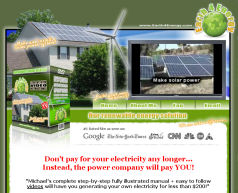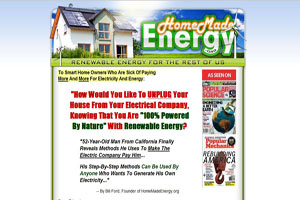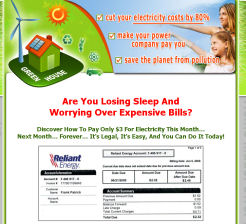|
|
|
Close Help | ||||||||||||||
|
|
WindSolarEnergy.ORG Advice for
Achieving |
| |
|
|
|
|||||||||||||||||||||||||||||||||||||||||||||||||||||||||||||||||||||||||||||||||||||||||||||||||||||||||||||||||||||||||||||||||||||||||||||||||||||||||||||||||||||||||||||||||||||||||||||||||||||||||||||||||||||||||||||||||||||||||||||||||||
| Seller | Brand | Watts | Price including shipping | Price Per Watt |
| Ebay | Evergreen | |||
| Solar-Electric.com | Kyocera | 205 | $868 + $102.57 | $4.73 |
| Altenergystore.com |
Watch out for companies that advertise a cheap price, but then charge very high shipping fees. The final price is what really counts.
Because solar panels have no moving parts, they can last 25 years or more. Some solar panels have 20 year warranties on them, promising 80% of their rated power after 20 years.
Wind turbine shopping
Wind turbines convert kinetic wind power to electric power. They consist of three blades and are mounted on high poles, rooftops and towers. They typically have a tail which moves them in the direction of the wind for maximum efficiency.
When shopping for wind turbines, you'll want to ignore the wattage rating of the turbine itself and instead focus on the charts that each manufacturer provides. The wattage rating of various turbines such as the "Bergey 1000" or the "Whisper 500" represents the power produced at very high wind speeds. Since you might only get these speeds in gusts, it is not necessarily a reliable measure of sustained energy.
When looking at the charts and graphs that each turbine manufacturer provides, look at the average monthly energy output based on the average wind speed in your area. Read our article with the map of the best regions for wind power for finding the average wind speed in your area.
Once you have the necessary data, you can do a comparison like this:
| Seller | Brand | Model | Price incl. shipping | KWH production | Price per KWH |
| Ebay | |||||
| Solar-Electric.com | |||||
| Altenergystore.com | Bergey | BWC 1000W | $2880.73 |
240 |
$12 |
Wind Turbine Tower shopping
If you are able to afford the initial cost, it is well worth it to install some kind of tower to raise the height of the wind turbine to where it will catch more wind. It is usually more cost effective to purchase a small turbine along with a tall tower than to buy a large turbine that isn't high enough to catch a consistent wind. More information on the importance of tower height can be found in our How Wind Energy Works article.
As the chart in the best regions for wind power article demonstrates, the performance of your wind turbine is dramatically affected by the height of installation. You will want to consult this chart when determining how high you want to build your tower. The highest towers always give you the highest average wind speeds, but they also cost the most. Finding the best value will depend on the kind of tower you build and the amount of additional KWH you will produce per foot of tower height.
There are various kinds of tower systems that can be employed. The kind of tower you want will depend on your local building codes, the amount of space you want to dedicate to a wind turbine, and the unique features of your property. For instance, if your property is already on the top of a hill, your need for a tall tower won't be as great.
Determining the height of your wind turbine tower will also depend on the amount of additional energy will be produced, and the costs required in producing that additional energy. Consult the chart included with your wind turbine
Once you have determined the best kind of tower for your location, you can employ the following chart to determine the best value:
| Seller | Brand | Model | Price incl. shipping | Price per foot |
The least expensive tower system typically uses guyed wires to hold the tower in place, but the guyed wires can take up a tremendous amount of space. One option is to have your local electric company install a 30 or 40 foot electric pole. As long as you have a way to install and maintain the wind turbine unit, this is usually a nice cost effective option.
Inverters
Inverters convert the Direct Current (DC) voltage stored by your batteries to the Alternating Current (AC) voltage required by your household appliances and lights.
Inverter pricing continues to be on a downward trend and this has made Solar and Wind Energy a more affordable solution for many.
The kind of inverter you purchase will depend on whether you are installing a 24 volt or 48 volt system. It will also depend on wattage needs of your particular household. See our "Power Hungry Appliances" article.
Sometimes it is cheaper to purchase several small inverters than it is to run one large inverter. An 1800 watt inverter would supply enough electricity for one 15 amp electric circuit. A person could
Some inverters add a "peak" rating of twice the rated wattage. This is helpful when running circuits that use electric motors. Electric motors are found in vacuum cleaners, circular saws, blenders, fans, etc. When electric motors start from a dead stop, it will use more wattage until it achieves its rated speed. The "peak" rating is a short term wattage rating to allow for this.
Inverters are designed for a "off grid" or "on grid" Solar and Wind energy systems. Off-grid inverters require a battery while on-grid Intertie inverters do not. There are also inverters that are both on and off grid compatible. They are normally on-grid, but will switch to off-grid if there is a power failure.
Once you have determined the best kind of inverter for your system, you can employ the following chart to determine the best value:
| Seller | Brand | Model | Price incl. shipping | Watt rating | Price per watt |
Make sure you compare the warranties and overall quality of each inverter before coming to a decision.
Batteries
Batteries are only necessary for off-grid systems. Electricity storage can be expensive, but there are ways to reduce costs. The "Do it yourself" (DIY) guides we reviewed have some excellent ideas for getting inexpensive or even free batteries.
The specific kind of battery used in renewable energy setups are Deep Cycle batteries. Deep cycle batteries are designed to be discharged and recharged repeatedly. Car batteries are designed to run at a full charge most of the time with cranking amperage available to start the car. Never use a car battery or any battery advertising "Cold cranking amps" in a renewable energy system--even if they are called "Deep cycle" batteries. Batteries for renewable energy installations have no need for "cold cranking amps." Energizer, Optima, and Everstart are among the brands advertising cranking amps.
Deep cycle batteries will last the longest if they are never discharged below 50%. Keep this in mind when considering the number of batteries you will need for your renewable energy system. The more batteries you purchase, the longer life you can expect from them.
When shopping for a Deep Cycle battery to purchase, you have the option of choosing a Flooded Lead Acid (FLA) battery or sealed batteries such as the Absorbed Glass Mat (AGM) or Gel cell. Here are the advantages and disadvantages of each:
| FLA | Gel cell | AGM sealed | |
| Advantages |
|
|
|
| Disadvantages |
|
|
|
FLA batteries are the best choice for most systems. If you need to put the batteries indoors, don't purchase Flooded Lead Acid batteries because they emit flammable hydrogen.
Once you have decided which type of battery best suits your needs, you need to make sure you choose a battery configuration that will result in the desired voltage. If you want a 24 volt system, you can wire two 12 volt batteries together in series, then piggyback any additional batteries. A 48 volt system would require a minimum of 4 12 volt batteries, wired in series, to achieve the 48 volts.
To wire batteries in series, suppose you have two batteries right next to each other with the negative terminal of each battery being on the left and positive on the right. You will use the negative terminal of the left battery to feed negative polarity to your inverter. You will then connect the positive terminal of the left battery to the negative terminal of the battery on the right side. Then use the positive terminal of the right battery to connect to the inverter. This will give you double the voltage. A 48 volt system would require you to chain four batteries together in the same manner.
Its important to understand that amps are a measurement of electrical current. Basically, it is a way of finding out how much electricity is being discharged from a battery or other power source. Voltage is a measurement of electrical force coming out of the battery.
A 12 volt battery running at 10 amps only supplies half of the amount of electricity that a 24 volt battery is supplying at 10 amps. A 24 volt battery running at 5 amps is supplying the same amount of electricity as a 12 volt battery at 10 amps. For this reason, a more accurate measurement of electricity is wattage. Watts are calculated by multiplying Volts X Amps. A 60 watt light bulb hooked up to a 12 volt battery would require 5 amps of electricity (12 volts X 5 Amps = 60 watts).
When choosing a specific brand of battery, it is very easy to be misled. Battery companies have different ways of rating their batteries and it is important to understand the systems involved so you can make a wise choice.
When shopping for batteries, you will see one of the following ways the manufacturer chose to rate their batteries:
Amp hour rating: This is the amount of amperes a battery will supply over a certain number of hours of discharge. Because a battery will supply more amperes if discharged over a long period of time, and less amperes if it is discharged quickly, this can be very misleading. When you see an amp-hour rating, make absolutely sure you find out from the supplier or manufacturer the length of time involved in the amp-hour rating. 20 hours is the standard.
Reserve capacity: This is the amount of minutes a battery can supply a useful voltage when it is under a load of X number of amps. This is more accurate measure of how a battery will perform under a heavy load.
Cycle Life: Battery companies will sometimes resist divulging this information, but it is basically a measurement of how many times a battery can withstand a charge and discharge. The more times it can withstand a charge and discharge, the greater the life of the battery will be. A battery that is regularly drained of all its power will not last as long as a battery that averages only a 50% discharge before being fully charged again. If a company supplies you with a cycle life, make sure it is an actual tested rating rather than a theoretical estimate.
When comparing batteries that use the amp hour rating with those that use the reserve capacity rating, choose companies that give a 20-24 hour time of discharge. Most companies use a 20 hour rating. Then you can use the following chart to give an accurate comparison of what kind of power you can expect from a battery:
| Seller | Brand | Model | Price incl. shipping | Watts (Volts X Amps) |
50% Cycle life | 100% Cycle Life/cents per KW |
| altenergystore.com | Surrette | 12-cs-11ps | $1069.48 285.00 |
4284 | 3300/7.5 | 1500/21.1 |
| altenergystore.com | Surrette | 2-ks-33ps | $874.90 285.00 |
3531 | 3300/7.5 | 1500/21.9 |
| solar-electric.com | Surrette | 4CS-17PS | $581.00 | 2184 | 3300/8.1 | 1500/17.7 |
| solar-electric.com | Surrette | 6CS-17PS | $871.00 | 3276 | 3300/8.1 | 1500/17.6 |
| solar-electric.com | Surrette | 6CS-25PS (pu) | $1205.00 | 4920 | 3300/7.4 | 1500/16.3 |
| Ebay | Trojan | L16RE-B | $449.95 | 2220 | 1300/15.5 | 850/23.8 |
| Ebay | Trojan | L16RE-A | $509.95 | 1950 | 1300/20.1 | 850/30.7 |
| Ebay | Trojan | T-105 | $234.95 | 1350 | 1300/13.3 | 700/24.8 |
| solar-electric.com |
Crown |
CR-225 | $165.00 | 1350 | 775/15.7 | 625/19.5 |
| solar-electric.com | Crown | CR-395 | $337.50 | 2370 | 775/18.3 | 650/21.9 |
As you can see from the above table, the Surrette (also called Rolls) battery, towers over all the others in economical sense. However, the initial expense may be out of reach for some customers.
The Trojan batteries claim to have 1300 cycles at 50% discharge, but we have learned that this is "estimated" and not a truly tested rating. For this reason, we believe it is suspect. Trojan also has a lower rating at the Better Business Bureau ("B" rating) than Crown ("A" rating) which suggests possible customer service problems.
Crown batteries are the next most economical choice and are likely to take more abuse if you happen to go below a 50% discharge on your batteries. Our research indicates that they are the heaviest of the batteries and have a cycle life of 1000. The heavier a battery, the longer it's cycle life and better its performance will be. This is due to the thickness of the plates.
It might be easy to look at the above table and wonder how a person is going to save any money by using wind and solar. Electric power usually costs between 7 and 10 cents per KW, and just the batteries in the above charts can cost at least that. But it's important to remember that you are often using the wind and solar energy just as quickly as it is being fed into the system. Sometimes, the battery may hardly be discharging at all, and the amount of energy being generated is equal to or greater than the amount of energy you are using. The more you can keep yourself from draining the battery, the more money you will save in the long run. Of course, this means more investment in solar and wind power components so your initial expense will be higher.
Battery Maintenance
With FLA batteries you will need to keep the cells full of distilled water. Do not use tap water or plates will load up with minerals and/or chemical residue, decreasing their effectiveness and shortening their life.
Do not use a battery rejuvenator (additive). They may help with car batteries, but are not well suited for deep cycle batteries.
Keep in mind that FLA batteries emit explosive hydrogen gas when in use. Do not install them indoors unless it is in a well-vented location.
It is important to remember that the terminals will need occasional cleaning. Dirty terminals can significantly shorten the life of a battery. If you are going to use more than 4 battery banks in parallel, it is especially important to keep the connections very clean. The more connections you have, the more likely there will be a voltage drop that can reduce the effectiveness of the batteries. 80% of service calls are due to dirty battery terminals.
It is important to equalize or desulfate the batteries regularly. This will charge the batteries at one volt higher than normal and helps the batteries last longer.
![]() Bookmark
With del.icio.us
Bookmark
With del.icio.us ![]() Digg
this story
Digg
this story ![]() Submit
to StumbleUpon
Submit
to StumbleUpon
Top Do It Yourself Guides - Purchased and reviewed
| Number one | Number two | Number three |
 |
 |
 |
| Earth4Energy | Home Made Energy | Home Made Power Plan |
| Click here to
visit Earth4Energy |
Click here to
visit Home Made Energy |
Click here to
visit Home Made Power Plan |
| Full Review | Full Review | Full Review |
WindSolarEnergy.ORG is a free resource offering
advice on achieving renewable energy independence
On the site you will find valuable articles covering
how wind energy is harnessed through wind turbines, how solar energy is
harnessed through photovoltaic solar panels, best locations for Wind Power and much more. You will
also find helpful reviews of Do it Yourself guides that we have
purchased and researched.
If you found this site useful, spread the word and help others find WindSolarEnergy.ORG
by adding us to your favorite social bookmarking site:
![]() Bookmark
With del.icio.us
Bookmark
With del.icio.us ![]() Digg
this story
Digg
this story ![]() Submit
to StumbleUpon
Submit
to StumbleUpon
All rights reserved. Copyright ©
WindSolarEnergy.ORG 2008-2009
Privacy Policy